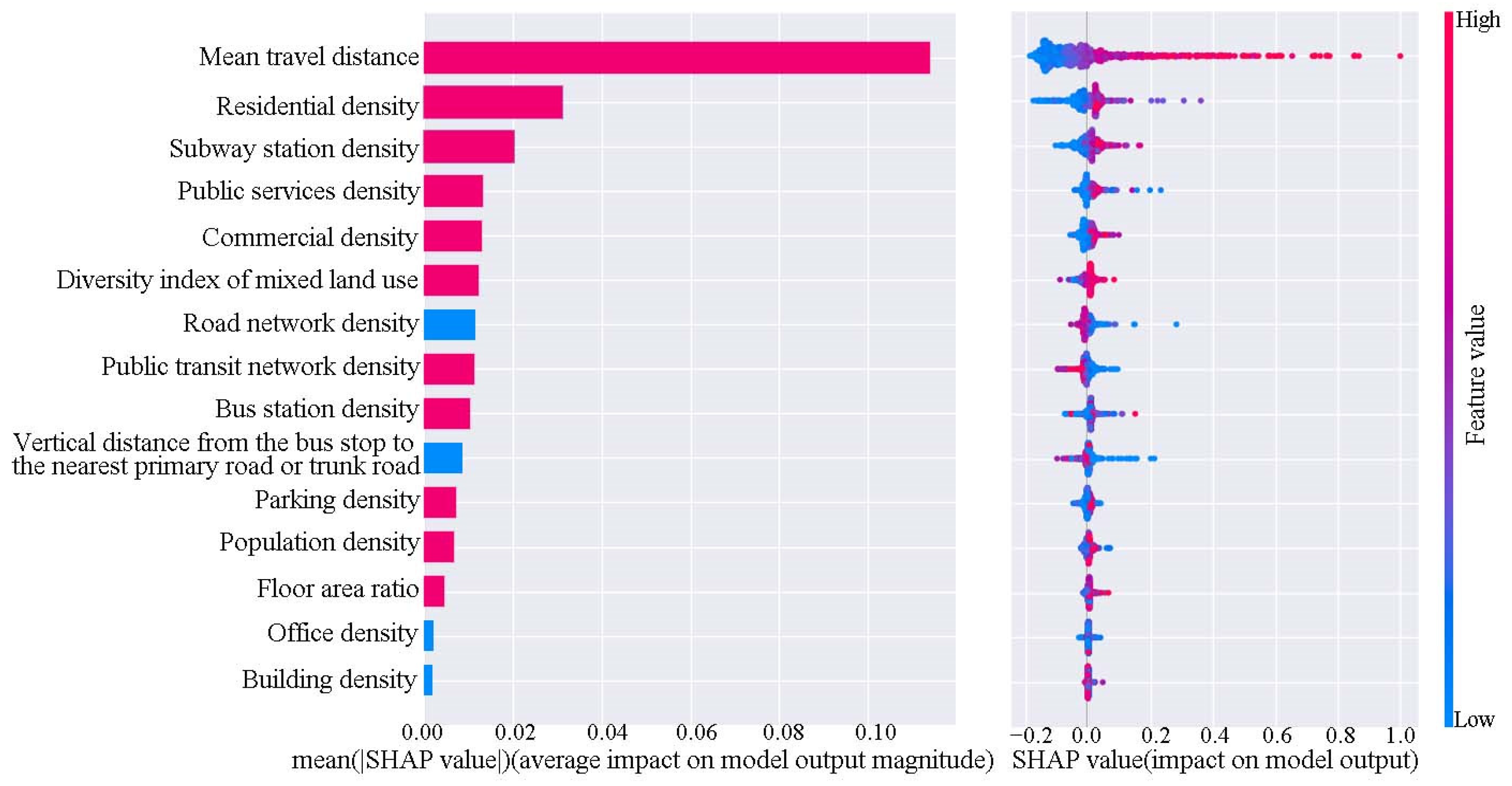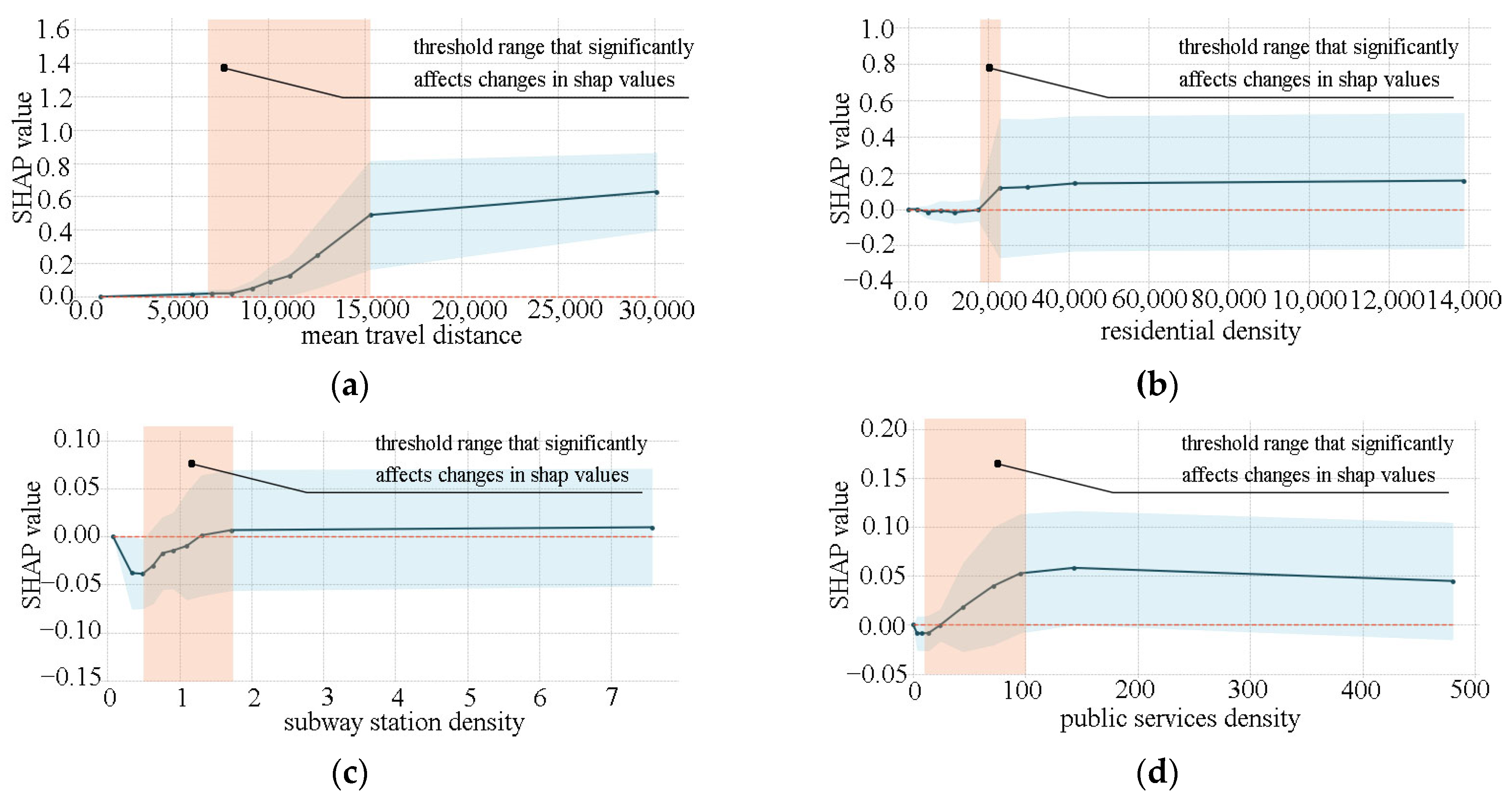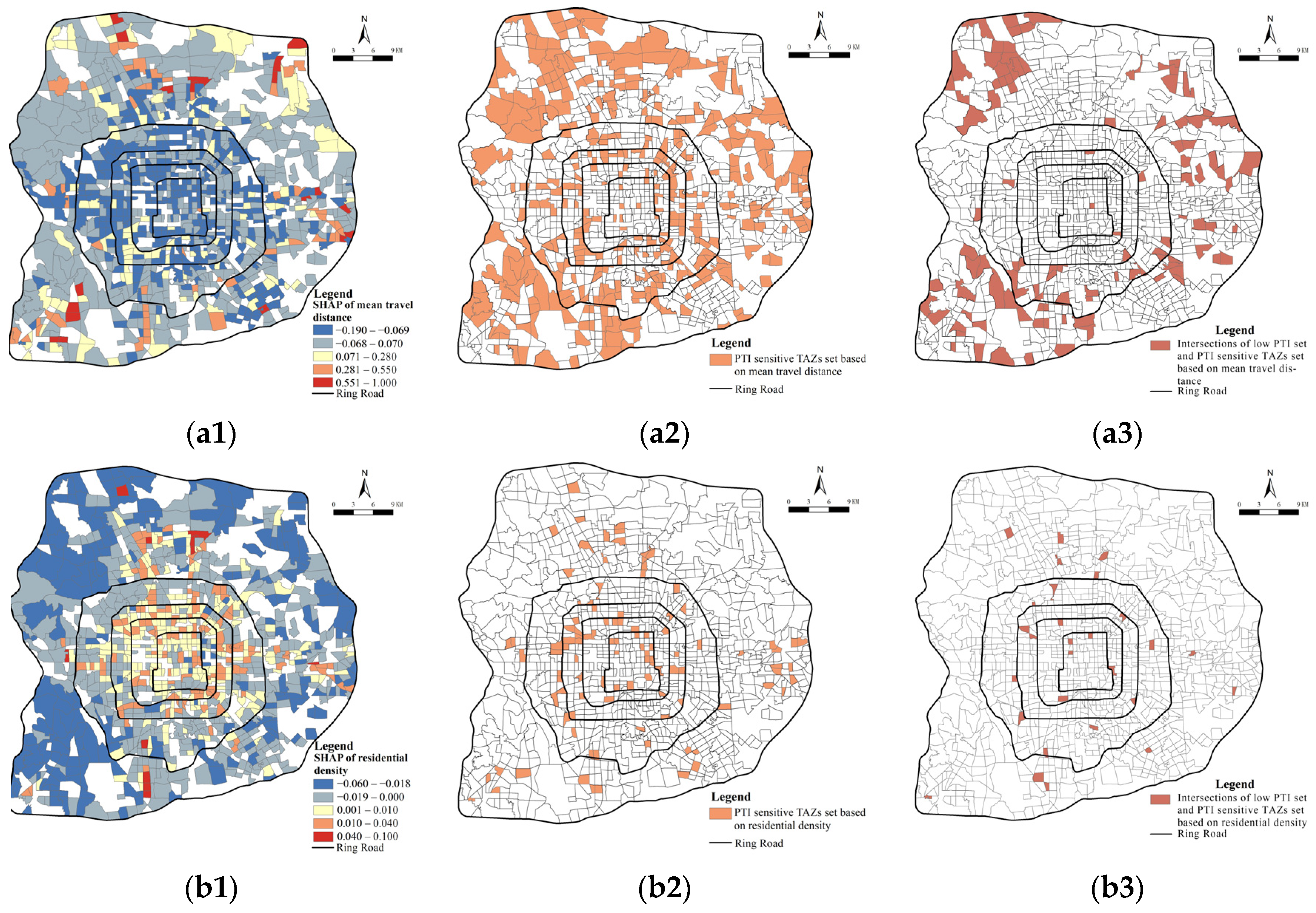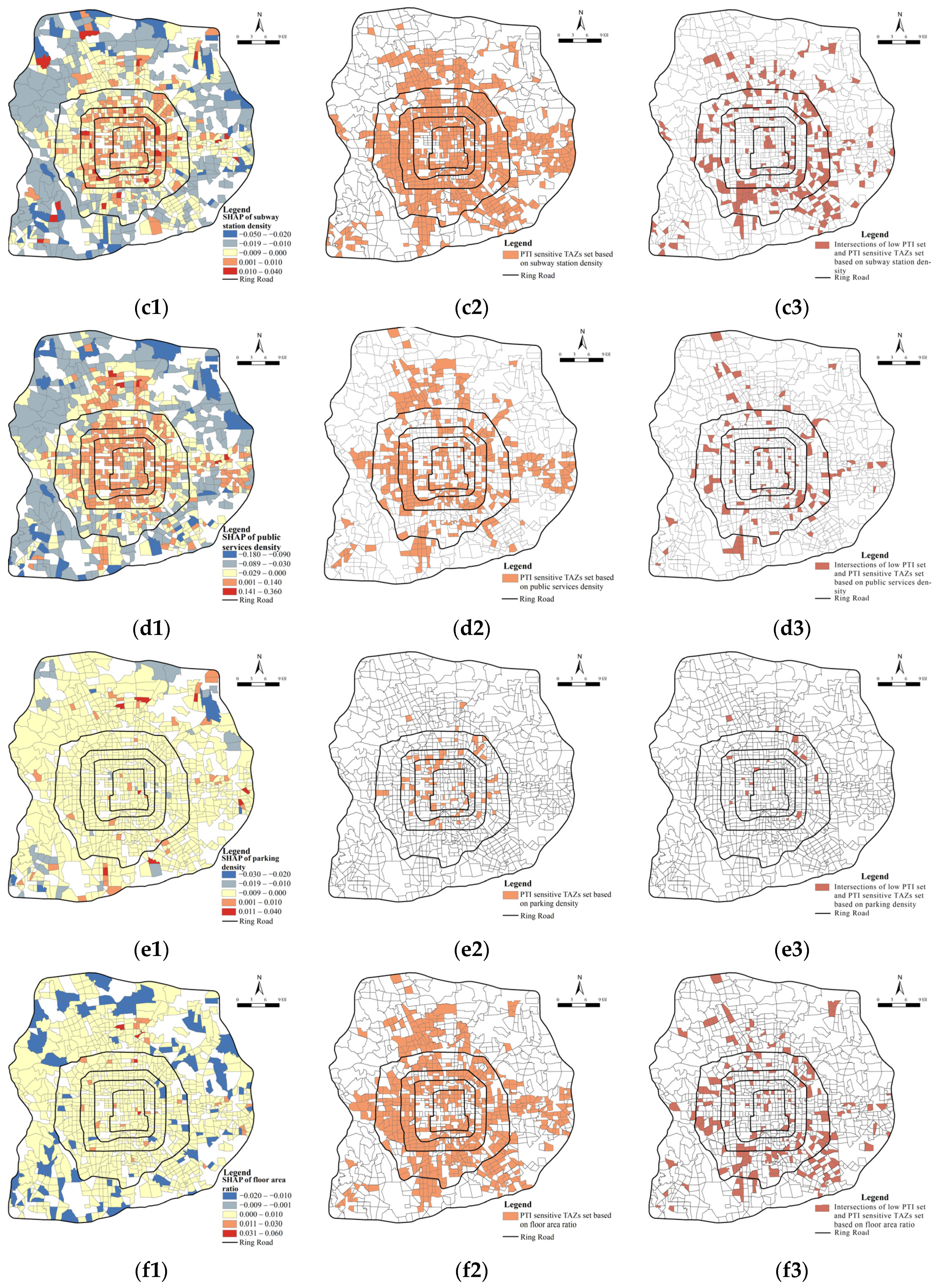Investigating the Nonlinear Effect of Land Use and Built Environment on Public Transportation Choice Using a Machine Learning Approach
Abstract
1. Introduction
- (1)
- Compare the goodness of model fitting for different scale grids, TAZs, and neighborhoods as spatial units and identify the optimal spatial unit.
- (2)
- Explore the extent to which the land use and built environment variables affect the PTI based on the optimal spatial unit.
- (3)
- XGBoost was used to explore the nonlinear relationship and threshold effect of land use variables on PTI. The spatial units with priority renewal will be identified based on research findings.
2. Data Sources and Methods
2.1. Overview of the Study Area and Data Sources
2.2. Methods
2.2.1. The Public Transportation Index
2.2.2. XGBoost
2.2.3. Explanation of Machine Learning Models: SHAP (Shapley Additive Explanations)
2.3. Land Use Explanatory Variables
3. Results and Discussion
3.1. Optimal Scale and Shape of the Spatial Unit
3.2. Global Impact of Explanatory Variables on PTI
3.3. Analysis of Nonlinear Relationships in Land Use
3.4. Spatial Heterogeneity of Land Use Effects on PTI
4. Conclusions and Limitations
- (1)
- The results of the study on the impact of land use on PTI are different for different spatial units. A comparison of the goodness of XGBoost of different spatial units shows that the optimal spatial unit to study the impact of land use on PTI in Beijing is TAZ.
- (2)
- The XGBoost fitting results show that the top four explanatory variables affecting PTI are, in order: mean travel distance, residential density, subway station density, and public services density.
- (3)
- Some land use and built environment variable have nonlinear effect on PTI and threshold effect results are conducive to propose effective built environment renewal strategies aiming at increasing PTI or public transportation share.
- (4)
- The TAZs with priority renewal were identified according to intersection analysis of the low-PTI set and the PTI-sensitive TAZs based on different land use variables. This has important reference significance for the targeted selection of TAZ for urban built environment renewal.
Supplementary Materials
Author Contributions
Funding
Data Availability Statement
Acknowledgments
Conflicts of Interest
References
- Mraihi, R.; Harizi, R.; Mraihi, T.; Bouzidi, M.T. Urban air pollution and urban daily mobility in large Tunisia’s cities. Renew. Sustain. Energy Rev. 2015, 43, 315–320. [Google Scholar] [CrossRef]
- Lee, Z.; Hwang, S.; Kim, J. Optimal Planning of Real-Time Bus Information System for User-Switching Behavior. Electronics 2020, 9, 1903. [Google Scholar] [CrossRef]
- Cardozo, O.D.; García-Palomares, J.C.; Gutiérrez, J. Application of geographically weighted regression to the direct forecasting of transit ridership at station-level. Appl. Geogr. 2012, 34, 548–558. [Google Scholar] [CrossRef]
- Sun, B.D.; Ermagun, A.; Dan, B. Built environmental impacts on commuting mode choice and distance: Evidence from Shanghai. Transp. Res. Part D Transp. Environ. 2017, 52, 441–453. [Google Scholar] [CrossRef]
- Kim, S.; Lee, S. Nonlinear relationships and interaction effects of an urban environment on crime incidence: Application of urban big data and an interpretable machine learning method. Sustain. Cities Soc. 2023, 91, 104419. [Google Scholar] [CrossRef]
- Yoshinaga, K.; Onodera, M.; Shirai, K.; Yoshizawa, N.; Yanagawa, H.; Kito, T. Analysis of Stakeholders’ Trust Level in the Nuclear Energy Domain in Japan. J. Nucl. Eng. Radiat. Sci. 2025, 11, 012204. [Google Scholar] [CrossRef]
- Saigal, T.; Vaish, A.K.; Rao, N.V.M. Understanding environmentally sustainable Indian travel behaviour: An analysis of 2011 census data. J. Soc. Econ. Dev. 2024, 26, 49–76. [Google Scholar] [CrossRef]
- Liu, X.T.; Wu, J.W.; Huang, J.W.; Zhang, J.W.; Chen, B.Y.; Chen, A. Spatial-interaction network analysis of built environmental influence on daily public transport demand. J. Transp. Geogr. 2021, 92, 102991. [Google Scholar] [CrossRef]
- An, R.; Wu, Z.H.; Tong, Z.M.; Qin, S.X.; Zhu, Y.; Liu, Y.L. How the built environment promotes public transportation in Wuhan: A multiscale geographically weighted regression analysis. Travel Behav. Soc. 2022, 29, 186–199. [Google Scholar] [CrossRef]
- Crotti, D.; Grechi, D.; Maggi, E. Proximity to public transportation and sustainable commuting to college. A case study of an Italian suburban campus. Case Stud. Transp. Policy 2022, 10, 218–226. [Google Scholar] [CrossRef]
- Jerrett, M.; Su, J.G.; MacLeod, K.E.; Hanning, C.; Houston, D.; Wolch, J. Safe Routes to Play? Pedestrian and Bicyclist Crashes Near Parks in Los Angeles. Environ. Res. 2016, 151, 742–755. [Google Scholar] [CrossRef]
- Nadeem, M.; Matsuyuki, M.; Tanaka, S. Impact of bus rapid transit in shaping transit-oriented development: Evidence from Lahore, Pakistan. J. Asian Archit. Build. Eng. 2023, 22, 3635–3648. [Google Scholar] [CrossRef]
- Chakour, V.; Eluru, N. Examining the influence of stop level infrastructure and built environment on bus ridership in Montreal. J. Transp. Geogr. 2016, 51, 205–217. [Google Scholar] [CrossRef]
- Goliszek, S. The potential accessibility to workplaces and working-age population by means of public and private car transport in Szczecin. Misc. Geogr. 2022, 26, 31–41. [Google Scholar] [CrossRef]
- De Gruyter, C.; Gunn, L.; Kroen, A.; Saghapour, T.; Davern, M.; Higgs, C. Exploring changes in the frequency of public transport use among residents who move to outer suburban greenfield estates. Case Stud. Transp. Policy 2022, 10, 341–353. [Google Scholar] [CrossRef]
- Handy, S.L.; Boarnet, M.G.; Ewing, R.; Killingsworth, R.E. How the built environment affects physical activity: Views from urban planning. Am. J. Prev. Med. 2002, 23, 64–73. [Google Scholar] [CrossRef] [PubMed]
- Kahn, M.E. A Review of Travel by Design: The Influence of Urban Form on Travel. Reg. Sci. Urban Econ. 2002, 32, 275–277. [Google Scholar] [CrossRef]
- Ewing, R.; Cervero, R. Travel and the Built Environment. J. Am. Plan. Assoc. 2010, 76, 265–294. [Google Scholar] [CrossRef]
- Larriva, M.T.B.; Büttner, B.; Durán-Rodas, D. Active and healthy ageing: Factors associated with bicycle use and frequency among older adults- A case study in Munich. J. Transp. Health 2024, 35, 101772. [Google Scholar] [CrossRef]
- Openshaw, S. A geographical solution to scale and aggregation problems in region-building, partitioning and spatial modelling. Trans. Inst. Br. Geogr. 1977, 2, 459–472. [Google Scholar] [CrossRef]
- Lee, S.I.; Lee, M.; Chun, Y.; Griffith, D.A. Uncertainty in the effects of the modifiable areal unit problem under different levels of spatial autocorrelation: A simulation study. Int. J. Geogr. Inf. Sci. 2019, 33, 1135–1154. [Google Scholar] [CrossRef]
- Gao, F.; Li, S.Y.; Tan, Z.Z.; Wu, Z.F.; Zhang, X.M.; Huang, G.P.; Huang, Z.W. Understanding the modifiable areal unit problem in dockless bike sharing usage and exploring the interactive effects of built environment factors. Int. J. Geogr. Inf. Sci. 2021, 35, 1905–1925. [Google Scholar] [CrossRef]
- Mills, O.; Shackleton, N.; Colbert, J.; Zhao, J.F.; Norman, P.; Exeter, D.J. Inter-relationships between geographical scale, socio-economic data suppression and population homogeneity. Appl. Spat. Anal. Policy 2022, 15, 1075–1091. [Google Scholar] [CrossRef]
- Altan, M.F.; Ayozen, Y.E. The Effect of the Size of Traffic Analysis Zones on the Quality of Transport Demand Forecasts and Travel Assignments. Period. Polytech.Civ. Eng. 2018, 62, 971–979. [Google Scholar] [CrossRef]
- Sun, G.D.; Chang, B.F.; Zhu, L.; Wu, H.; Zheng, K.; Liang, R.H. TZVis: Visual analysis of bicycle data for traffic zone division. J. Vis. 2019, 22, 1193–1208. [Google Scholar] [CrossRef]
- Thomsen, N. Implementing a Ride-sharing Algorithm in the German National Transport Model (DEMO). Transp. Res. Rec. 2023, 2677, 1–10. [Google Scholar] [CrossRef]
- Lee, J.; Kang, T.W.; Choi, Y.S.; Jung, J.W. Clearance-Based Performance-Efficient Path Planning Using Generalized Voronoi Diagram. Int. J. Fuzzy Log. Intell. Syst. 2023, 23, 259–269. [Google Scholar] [CrossRef]
- Breitkreutz, D.; Lee, I. Investigation into Alternative Representations for Intelligent Geoinformation Systems in Data-rich Environments. J. Softw. 2009, 4, 777–784. [Google Scholar] [CrossRef][Green Version]
- Ketterer, C.; Gangwisch, M.; Fröhlich, D.; Matzarakis, A. Comparison of selected approaches for urban roughness determination based on voronoi cells. Int. J. Biometeorol. 2017, 61, 189–198. [Google Scholar] [CrossRef]
- Ordoñez, D.M.T.; Batac, R.C. Cascade events in geographical space. Int. J. Mod. Phys. C 2022, 33, 2250050. [Google Scholar] [CrossRef]
- Nguyen, Q.C.; Tasdizen, T.; Alirezaei, M.; Mane, H.; Yue, X.H.; Merchant, J.S.; Yu, W.J.; Drew, L.; Li, D.P.; Nguyen, T.T. Neighborhood built environment, obesity, and diabetes: A Utah siblings study. SSM-Popul. Health 2024, 26, 101670. [Google Scholar] [CrossRef]
- Nguyen, Q.C.; Sajjadi, M.; McCullough, M.; Pham, M.; Nguyen, T.T.; Yu, W.J.; Meng, H.W.; Wen, M.; Li, F.F.; Smith, K.R.; et al. Neighbourhood looking glass: 360° automated characterisation of the built environment for neighbourhood effects research. J. Epidemiol. Community Health 2018, 72, 260–266. [Google Scholar] [CrossRef]
- Mazumdar, S.; Jaques, K.; Conaty, S.; De Leeuw, E.; Gudes, O.; Lee, J.W.; Prior, J.; Bin, J.; Harris, P. Hotspots of change in use of public transport to work: A geospatial mixed method study. J. Transp. Health 2023, 31, 101650. [Google Scholar] [CrossRef]
- Pei, T.; Sobolevsky, S.; Ratti, C.; Shaw, S.L.; Li, T.; Zhou, C.H. A new insight into land use classification based on aggregated mobile phone data. Int. J. Geogr. Inf. Sci. 2014, 28, 1988–2007. [Google Scholar] [CrossRef]
- Wali, B.; Santi, P.; Ratti, C. A joint demand modeling framework for ride-sourcing and dynamic ridesharing services: A geo-additive Markov random field based heterogeneous copula framework. Transportation 2023, 50, 1809–1845. [Google Scholar] [CrossRef]
- Correia, G.H.D.; Silva, J.D.E.; Viegas, J.M. Using latent attitudinal variables estimated through a structural equations model for understanding carpooling propensity. Transp. Plan. Technol. 2013, 36, 499–519. [Google Scholar] [CrossRef]
- Singh, Y.R.; Shah, D.B.; Kulkarni, M.; Patel, S.R.; Maheshwari, D.G.; Shah, J.S.; Shah, S. Current trends in chromatographic prediction using artificial intelligence and machine learning. Anal. Methods 2023, 15, 2785–2797. [Google Scholar] [CrossRef] [PubMed]
- Cervero, R.; Kockelman, K. Travel demand and the 3Ds: Density, diversity, and design. Transp. Res. Part D Transp. Environ. 1997, 2, 199–219. [Google Scholar] [CrossRef]
- Uddin, M.; Anowar, S.; Eluru, N. Modeling freight mode choice using machine learning classifiers: A comparative study using Commodity Flow Survey (CFS) data. Transp. Plan. Technol. 2021, 44, 543–559. [Google Scholar] [CrossRef]
- Fakhri, D.; Khodayari, A.; Mahmoodzadeh, A.; Hosseini, M.; Ibrahim, H.H.; Mohammed, A.H. Prediction of Mixed-mode I and II effective fracture toughness of several types of concrete using the extreme gradient boosting method and metaheuristic optimization algorithms. Eng. Fract. Mech. 2022, 276, 108916. [Google Scholar] [CrossRef]
- Metzler, A.B.; Nathvani, R.; Sharmanska, V.; Bai, W.; Muller, E.; Moulds, S.; Agyei-Asabere, C.; Adjei-Boadi, D.; Kyere-Gyeabour, E.; Tetteh, J.D.; et al. Phenotyping urban built and natural environments with high-resolution satellite images and unsupervised deep learning. Sci. Total Environ. 2023, 893, 164794. [Google Scholar] [CrossRef]
- Sibindi, R.; Mwangi, R.W.; Waititu, A.G. A boosting ensemble learning based hybrid light gradient boosting machine and extreme gradient boosting model for predicting house prices. Eng. Rep. 2023, 5, e12599. [Google Scholar] [CrossRef]
- Elorza, M.; Castellano, E.; Segura, S. Prediction of customer demand for perishable products in retail inventory management, using the hybrid prophet-XGBoost model during the post-COVID-19 period. Appl. Econ. Lett. 2024, 1–7. [Google Scholar] [CrossRef]
- Fatty, A.; Li, A.J.; Qian, Z.G. An interpretable evolutionary extreme gradient boosting algorithm for rock slope stability assessment. Multimed. Tools Appl. 2023, 83, 46851–46874. [Google Scholar] [CrossRef]
- Rabby, Y.W.; Hossain, M.B.; Abedin, J. Landslide susceptibility mapping in three Upazilas of Rangamati hill district Bangladesh: Application and comparison of GIS-based machine learning methods. Geocarto Int. 2022, 37, 3371–3396. [Google Scholar] [CrossRef]
- Indhumathi, K.; Kumar, K.S. Efficient Prediction of Seasonal Infectious Diseases Using Hybrid Machine Learning Algorithms with Feature Selection Techniques. Int. J. Artif. Intell. Tools 2023, 32, 2350044. [Google Scholar] [CrossRef]
- Garcia-Retuerta, D.; Chamoso, P.; Hernández, G.; Guzmán, A.S.; Yigitcanlar, T.; Corchado, J.M. An Efficient Management Platform for Developing Smart Cities: Solution for Real-Time and Future Crowd Detection. Electronics 2021, 10, 765. [Google Scholar] [CrossRef]
- dos Santos, R.D., Jr.; Coelho, J.V.V.; Cacho, N.A.A.; de Araujo, D.S.A. A criminal macrocause classification model: An enhancement for violent crime analysis considering an unbalanced dataset. Expert Syst. Appl. 2024, 238, 121702. [Google Scholar] [CrossRef]
- Liu, J.X.; Xiao, L.Z.; Zhou, J.P.; Yang, L.C. Non-linear relationships between the built environment and walking to school: Applying extreme gradient boosting method. Prog. Geogr. 2022, 41, 251–263. [Google Scholar] [CrossRef]
- Shaik, R.U.; Unni, A.; Zeng, W.P. Quantum Based Pseudo-Labelling for Hyperspectral Imagery: A Simple and Efficient Semi-Supervised Learning Method for Machine Learning Classifiers. Remote Sens. 2022, 14, 5774. [Google Scholar] [CrossRef]
- Huang, B.; Wu, B.; Barry, M. Geographically and temporally weighted regression for modeling spatio-temporal variation in house prices. Int. J. Geogr. Inf. Sci. 2010, 24, 383–401. [Google Scholar] [CrossRef]
- Frank, L.D.; Pivo, G. Impacts of mixed use and density on utilization of three modes of travel: Single-occupant vehicle, transit, and walking. Transp. Res. Record 1994, 14, 44–52. [Google Scholar]
- Tao, T.; Cao, J. Exploring nonlinear and collective influences of regional and local built environment characteristics on travel distances by mode. J. Transp. Geogr. 2023, 109, 103599. [Google Scholar] [CrossRef]
- Lundberg, S.M.; Erion, G.G.; Su-In, L. Consistent Individualized Feature Attribution for Tree Ensembles. arXiv 2018, arXiv:1802.03888. [Google Scholar]
- Shannon, C.E.; Weaver, W. A Mathematical Theory of Communication. Philos. Rev. 1949, 5, 3–55. [Google Scholar]
- Wang, Z.B.; Wang, S.C.; Lian, H.T. A route-planning method for long-distance commuter express bus service based on OD estimation from mobile phone location data: The case of the Changping Corridor in Beijing. Public Transp. 2021, 13, 101–125. [Google Scholar] [CrossRef]
- Ji, S.; Wang, X.; Lyu, T.; Liu, X.; Wang, Y.; Heinen, E.; Sun, Z. Understanding cycling distance according to the prediction of the XGBoost and the interpretation of SHAP: A non-linear and interaction effect analysis. J. Transp. Geogr. 2022, 103, 103414. [Google Scholar] [CrossRef]
- Liu, X.; Chen, X.; Tian, M.; De Vos, J. Effects of buffer size on associations between the built environment and metro ridership: A machine learning-based sensitive analysis. J. Transp. Geogr. 2023, 113, 103730. [Google Scholar] [CrossRef]
- Han, H.R.; Yang, C.F.; Wang, E.R.; Song, J.P.; Zhang, M. Evolution of jobs-housing spatial relationship in Beijing Metropolitan Area: A job accessibility perspective. Chin. Geogr. Sci. 2015, 25, 375–388. [Google Scholar] [CrossRef]
- Currie, G.; Delbosc, A. Understanding bus rapid transit route ridership drivers: An empirical study of Australian BRT systems. Transp. Policy 2011, 18, 755–764. [Google Scholar] [CrossRef]
- Wang, Z.; Li, S.; Zhang, Y.; Wang, X.; Liu, S.; Liu, D. Built Environment Renewal Strategies Aimed at Improving Metro Station Vitality via the Interpretable Machine Learning Method: A Case Study of Beijing. Sustainability 2024, 16, 1178. [Google Scholar] [CrossRef]








| Traveler Number | Starting Station | Longitude of Origin Station | Latitude of Origin Station | Boarding Time | Destination Station | Longitude of Destination Station | Latitude of Destination Station | Alighting Time | Travel Distance (m) |
|---|---|---|---|---|---|---|---|---|---|
| 1 | Heping Men | 116.3842 | 39.9001 | 13 October 2020 9:00 | Huilong Guan | 116.3361 | 40.0708 | 13 October 2020 10:05 | 22,946.03 |
| 2 | Jianguo Men | 116.4358 | 39.9085 | 13 October 2020 9:01 | Jishuitan | 116.3731 | 39.94865 | 13 October 2020 9:40 | 9818.436 |
| 3 | Weigong Village | 116.3238 | 39.9529 | 13 October 2020 9:05 | Baishiqiao Nan | 116.3255 | 39.93626 | 13 October 2020 9:25 | 1986.12 |
| 4 | Zhongguan Village | 116.3165 | 39.98399 | 13 October 2020 9:08 | Tiantong Yuan | 116.4128 | 40.07522 | 13 October 2020 10:20 | 18,355.52 |
| “7D” Dimensions | Variables | Main Category | Description | Unit | Mean | Std. Dev. | Data Sources |
|---|---|---|---|---|---|---|---|
| Density | Building density | Land use and built environment | Total building base area divided by the spatial unit’s area | km/km2 | 0.17 | 0.09 | Open street map (https://lbs.amap.com/, accessed on 10 July 2022) |
| Commercial density | Land use | The number of commercial facilities divided by the spatial unit’s area | quantity/km2 | 99.85 | 106.87 | ||
| Public services density | Land use | The number of public service facilities divided by the spatial unit’s area | quantity/km2 | 57.37 | 64.89 | ||
| Office density | Land use | The number of office facilities divided by the spatial unit’s area | quantity/km2 | 120.76 | 159.96 | ||
| Residential density | Land use and built environment | The number of residents divided by the spatial unit’s area | person/km2 | 19,357.11 | 18,332.60 | Cell phone data [56] | |
| Diversity | Diversity index of mixed land use | Land use and built environment | Diversity index , is the ratio of the number of the ith class POIs to the number of all POIs. | 0.96 | 0.13 | Amap API (https://lbs.amap.com/, accessed on 10 July 2022) | |
| Design | Road network density | Land use and built environment | Length of road divided by the spatial unit’s area | km/km2 | 4.95 | 3.08 | Open street map (https://www.openstreetmap.org/, accessed on 10 July 2022) |
| Floor area ratio | Land use and built environment | The total construction area divided by the spatial unit’s area | 1.00 | 0.72 | |||
| Destination accessibility | Mean travel distance | Built environment | The average Manhattan distance of all public transportation trips whose origin locations are within a TAZ | m | 10,364.38 | 4329.88 | Processed transit trip record data based on IC card payments for public transportation (courtesy of Beijing Traffic Management) |
| Distance to transit | Public transportation network density | Land use and built environment | Length of public transport lines divided by the spatial unit’s area | km/km2 | 28.84 | 25.74 | Open street map (https://www.openstreetmap.org/, accessed on 10 July 2022) |
| Bus station density | Built environment | The number of bus stations divided by the spatial unit’s area | quantity/km2 | 34.08 | 31.13 | ||
| Subway station density | Built environment | The number of subway stations divided by the spatial unit’s area | quantity/km2 | 0.98 | 0.72 | ||
| Vertical distance from the bus stop to the nearest primary road or trunk road | Built environment | The mean value of vertical distance from the bus stop to the nearest primary road or trunk road | km | 2.20 | 3.09 | ||
| Demand management | Parking density | Land use and built environment | The number of parking lots divided by the spatial unit’s area | quantity/km2 | 32.57 | 36.27 | Amap API (https://lbs.amap.com/, accessed on 10 July 2022) |
| Demographics | Population density | Built environment | The population count divided by the spatial unit’s area | persons/km2 | 8856.57 | 5080.17 | Data from WorldPop (https://hub.worldpop.org/geodata/summary?id=24926, accessed on 10 July 2022) |
| Spatial Unit | Averge Spatial Unit Area (m2) | R2 | MAE | MSE | RMSE | MAPE |
|---|---|---|---|---|---|---|
| 200 m × 200 m | 40,000 | 0.27 | 1.17 | 13.32 | 3.65 | 6.94 |
| 300 m × 300 m | 90,000 | 0.32 | 0.15 | 0.23 | 0.48 | 5.02 |
| 400 m × 400 m | 160,000 | 0.07 | 0.40 | 1.46 | 1.21 | 6.05 |
| 500 m × 500 m | 250,000 | 0.01 | 0.32 | 0.74 | 0.86 | 6.99 |
| 600 m × 600 m | 360,000 | 0.18 | 0.28 | 0.89 | 0.94 | 6.43 |
| 700 m × 700 m | 490,000 | 0.33 | 0.21 | 0.35 | 0.59 | 4.03 |
| 800 m × 800 m | 640,000 | 0.23 | 0.17 | 0.17 | 0.41 | 4.70 |
| 900 m × 900 m | 810,000 | 0.01 | 0.18 | 0.13 | 0.36 | 6.26 |
| 1000 m × 1000 m | 1,000,000 | 0.21 | 0.18 | 0.28 | 0.53 | 3.80 |
| 1100 m × 1100 m | 1,210,000 | 0.32 | 0.13 | 0.08 | 0.29 | 3.62 |
| 1200 m × 1200 m | 1,440,000 | 0.06 | 0.13 | 0.06 | 0.25 | 6.26 |
| 1300 m × 1300 m | 1,690,000 | 0.23 | 0.12 | 0.06 | 0.25 | 5.25 |
| 1400 m × 1400 m | 1,960,000 | 0.22 | 0.11 | 0.04 | 0.20 | 5.67 |
| 1500 m × 1500 m | 2,250,000 | 0.12 | 0.11 | 0.04 | 0.20 | 5.41 |
| 1600 m × 1600 m | 2,560,000 | 0.16 | 0.09 | 0.02 | 0.13 | 5.76 |
| 1700 m × 1700 m | 2,890,000 | 0.23 | 0.11 | 0.04 | 0.21 | 4.30 |
| 1800 m × 1800 m | 3,240,000 | 0.03 | 0.12 | 0.04 | 0.20 | 4.04 |
| 1900 m × 1900 m | 3,610,000 | 0.30 | 0.10 | 0.04 | 0.20 | 6.04 |
| 2000 m × 2000 m | 4,000,000 | 0.34 | 0.10 | 0.03 | 0.16 | 4.26 |
| TAZs | 1,721,735 | 0.62 | 0.09 | 0.02 | 0.13 | 3.48 |
| neighborhood | 11,994,517 | 0.00 | 0.23 | 0.21 | 0.46 | 6.19 |
Disclaimer/Publisher’s Note: The statements, opinions and data contained in all publications are solely those of the individual author(s) and contributor(s) and not of MDPI and/or the editor(s). MDPI and/or the editor(s) disclaim responsibility for any injury to people or property resulting from any ideas, methods, instructions or products referred to in the content. |
© 2024 by the authors. Licensee MDPI, Basel, Switzerland. This article is an open access article distributed under the terms and conditions of the Creative Commons Attribution (CC BY) license (https://creativecommons.org/licenses/by/4.0/).
Share and Cite
Wang, Z.; Liu, S.; Lian, H.; Chen, X. Investigating the Nonlinear Effect of Land Use and Built Environment on Public Transportation Choice Using a Machine Learning Approach. Land 2024, 13, 1302. https://doi.org/10.3390/land13081302
Wang Z, Liu S, Lian H, Chen X. Investigating the Nonlinear Effect of Land Use and Built Environment on Public Transportation Choice Using a Machine Learning Approach. Land. 2024; 13(8):1302. https://doi.org/10.3390/land13081302
Chicago/Turabian StyleWang, Zhenbao, Shuyue Liu, Haitao Lian, and Xinyi Chen. 2024. "Investigating the Nonlinear Effect of Land Use and Built Environment on Public Transportation Choice Using a Machine Learning Approach" Land 13, no. 8: 1302. https://doi.org/10.3390/land13081302
APA StyleWang, Z., Liu, S., Lian, H., & Chen, X. (2024). Investigating the Nonlinear Effect of Land Use and Built Environment on Public Transportation Choice Using a Machine Learning Approach. Land, 13(8), 1302. https://doi.org/10.3390/land13081302





